TO
| Title | Date | Subject | Description | ||
|---|---|---|---|---|---|
| 1 |
 |
Population characteristics of the Salt Lake Metropolitan Area | 1964-01 | This study could not have been undertaken without the assistance of many. An expression of gratitude is due Dr. Osmond L. Harline, Director of the Bureau of Economic and Business Research, and Dr. Clyde N. Randall, Dean of the College of Business, of the University of Utah, who responded to the orig... | |
| 2 |
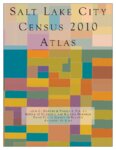 |
Salt Lake City census 2010 atlas | 2013-02 | Demographics; Salt Lake City; Utah; Census | This volume presents and analyzes results from the 2010 Census of Population and Housing. This mandatory enumeration is conducted by the federal government and is used to determine reapportionment and redistricting. This is the most complete record of population, households, and housing units that i... |
| 3 |
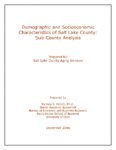 |
Demographic and socioeconomic characteristics of Salt Lake County: sub-county analysis | 2006-12 | Salt Lake County; Projections; Estimates; Aging population; Baby boom; Utah; Salt Lake Aging Services; Kennecott Land | This paper is an examination of the shifting geographic distribution of the population within Salt Lake County over time as well as an analysis of the spatial distribution of its demographic and socioeconomic characteristics. It builds on the county-level analysis included in a separate section of t... |
| 4 |
 |
Salt Lake County's distinctive demographics: implications for the aging population | 2006-12 | Salt Lake County; Projections; Estimates; Aging population; Baby boom; Utah; Salt Lake Aging Services; Kennecott Land | Salt Lake County is the economic, political, and cultural center of Utah. The county is currently home to nearly 40 percent of Utah residents and generates about half of all jobs in the state. It remains the most populous county, with a million of the state's 2.6 million residents,1 and its daytime ... |
| 5 |
 |
Multi-county regions in Utah | 1970-03 | The publication of this report was made possible through the financial assistance of the Four Corners Regional Commission with coordination by the State Planning Coordinator's Office, State of Utah. The statements, findings, conclusions, recommendations, and other data in this report are solely thos... | |
| 6 |
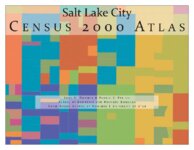 |
Salt Lake City census 2000 atlas | 2011-03 | Demographics; Salt Lake City; Utah; Census | This volume presents the basic demographic characteristics of residents of Salt Lake City as recorded in the 2000 Census of Population and Housing. Every ten years these federal governm ent counts of people are the basis of congressional apportionment and political redistricting. Data in this volume... |
| 7 |
 |
Salt Lake County's distinctive demographics: implications for the future | 2006-11 | Salt Lake County is the economic, political, and cultural center of Utah. The county is currently home to nearly 40% of Utah residents and generates about half of all jobs in the state. It remains the most populous county, with a million of the state's 2.6 million residents,2 and its daytime populat... | |
| 8 |
 |
Recreation in Utah a profile of the demand for outdoor recreation by out-of-state travelers to Utah | 1967-12 | A recurring problem when planning for economic and industrial development is the lack of sufficient basic data on which sound planning decisions can be based. One of the industry areas in which this lack of basic data has been conspicuous is the area of the out-of-state visitors' demand for Utah's o... | |
| 9 |
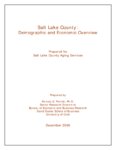 |
Salt Lake County: demographic and economic overview | 2006-12 | Salt Lake County; Utah; Demographics; Aging; Dependency ratio; Foreign born; Immigrants; Age structure; Age waves; Occupation; Labor force participation; Sex ratio; Educational attainment; commuting | Salt Lake County is the economic, political, and cultural center of Utah. The county is currently home to nearly 40 percent of Utah residents and generates about half of all jobs in the state. It remains the most populous county, with a million of the state's 2.6 million residents,1 and its daytime ... |
| 10 |
 |
Barriers to industrial development in Utah's portion of the four corners region | 1970-06-01 | Utah's portion of the Four Corners area is composed of the 21 counties which are south and/or east of Salt Lake County. The Utah Four Corners area covers 65,000 square miles which is approximately 80 percent of the state. The are a has a population of 274,500 dispersed throughout the region in a ver... | |
| 11 |
 |
Immigrants transform Utah: entering a new era of diversity | 2004-05 | Utah is generally perceived as an extremely homogeneous state whose population can trace its ancestry mostly to northern Europe. Listings for surnames like Hansen, Jensen, and Christensen do fill many pages in local telephone directories throughout the state. According to census counts, the minority... | |
| 12 |
 |
Baseline scenario 1998 | 1998-02 | ||
| 13 |
 |
An analysis of land use in the Salt Lake, Ogden and Utah Valley Area transportation studies 1960 1970, and 1995 | 1972-12 | In early 1971, the Center for Business and Economic Research contracted with the Utah State Department of Highways to develop and apply a methodology for forecasting employment, population, dwelling units and various land use categories for the Salt Lake Area Transportation Study (SLATS), the Ogden ... | |
| 14 |
 |
Employment and population analysis and projections Salt Lake Metropolitan Area, Utah and the United States | 1962-09 | Thomas A. McLean and Mrs. Connie P. Faulkner, graduate students in the Department of Economics, rendered very valuable assistance in the preparation of this report. The Utah Department of Employment Security was most cooperative and helpful in making available the necessary basic data for this stud... | |
| 15 |
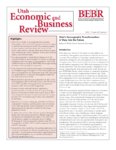 |
Utah's demographic transformation: a view into the future | 2008 | Utah, along with the rest of the nation, is in the midst of an extraordinary demographic transformation which has far from run its course. The confluence of four major trends continues to dramatically reshape the size and composition of the national and state populations. These trends include the ar... | |
| 16 |
 |
The economic & demographic impacts of the intermountain power project | 1982-04 | This report presents economic and demographic projections for the two-county (Millard and Juab) area to be impacted by the Intermountain Power Project located in western Millard County, Utah. The intermountain Power Agency has been planning the construction of the IPP project for quite some time. | |
| 17 |
 |
Employment, population, income and automobiles in Salt Lake, Ogden, Provo Metropolitan Area and State of Utah | 1966-12 | William C a r l i s l e and Michael A. Stoddard, graduate students in the Department of Economics, rendered v e r y valuable a s s i s t a n c e in the p r e p a r a tion of t h i s r e p o r t . Gregory M. Nielson, graduate student in Mathematics, a s s i s t e d in computer programming, and Iver... | |
| 18 |
 |
The changing composition of the State budget | 1976-04 | An issue of vital concern to all taxpayers and administrators of government is the distribution of state revenues from the various accounts to the departments of state government. A detailed account of the growth and changing patterns of state expenditures from 1969 to 1975 is presented in this issu... | |
| 19 |
 |
Critical issues in Utah's future: volume II | 1977-02 | ||
| 20 |
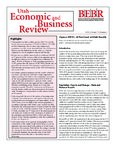 |
Census 2010 - a first look at Utah results | 2011 | Census; 2010; Utah; Demographics; Population; Age; Sex; Race; Ethnicity | Early results from the long-awaited 2010 Census are revealing the outlines of the more detailed portrait that will not be available for at least a couple more years. This essay reviews the top-level population change and geographic distribution results primarily from the redistricting data set.1 We ... |
| 21 |
 |
An industrial development information system for Utah | 1969-12 | ||
| 22 |
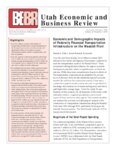 |
Economic and demographic impacts of federally financed transportation infrastructure on the Wasatch Front | 2004-09 | Over the next three decades, $14.4 billion (constant 2004 dollars) of new transit and highway infrastructure is planned to meet the transportation needs of the Wasatch Front.1 These investments will significantly influence the region's economic development potential, relative competitiveness, and la... | |
| 23 |
 |
Revised Utah population estimates for the 1990s | 2001-05 | Every 10 years, the U.S. Bureau of the Census conducts a population count. In the intervening years the Utah Population Es timates Committee (UPEC) annually prepares total resident population estimates for each of the 29 counties in the state. These estimates are based on methods that ut i l i z e s... | |
| 24 |
 |
Baseline scenario 1997 | 1997-09 | ||
| 25 |
 |
Economic, demographic and fiscal impacts of closing Hill Air Force Base: a statewide and regional analysis | 2004-04 | The upcoming round of Defense Base Closure and Realignment (BRAC) is threatening the existence of Hill Air Force Base (Hill AFB). The Department of Defense is aggressively approaching this round of BRAC in its attempt to eliminate 20% to 25% of current capacity. The purpose of this study is to asses... |
